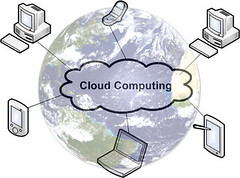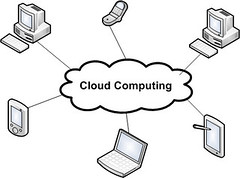
Evernote.com is another great example of a powerful cloud computing application that has many of the benefits of cloud computing. I use Evernote to drop items into a notebook that I need to be able to access from anywhere, (iPhone or any web connected computer). Being able to access information from anywhere and via any device is a key benefit to cloud computing. The real power Evernote brings to the table, in my opinion, is OCR, making everything I upload searchable. Then I thought, why not scan in all the paper that I keep (bills, etc) and put it into Evernote. What would happen?
Update (2/21/11): After using Evernote for about a year, I've updated this article with my discoveries and experiences. Also added new features in iPhone app released on 3/1/2011 at bottom.


 I recently started moving more of my business into the cloud. The business cloud application examples I’ve written about so far are more related to office productivity - word-processing, spreadsheets, and presentations. I took my small business and put its invoicing into the cloud by using the software as a service model (SAAS). Although I used ZOHO Invoice to do this, I’ll quickly discuss ZOHO along with others in it's class, like FreshBooks.
I recently started moving more of my business into the cloud. The business cloud application examples I’ve written about so far are more related to office productivity - word-processing, spreadsheets, and presentations. I took my small business and put its invoicing into the cloud by using the software as a service model (SAAS). Although I used ZOHO Invoice to do this, I’ll quickly discuss ZOHO along with others in it's class, like FreshBooks.
 This month’s botched upgrade to Hotmail by Microsoft is an example of one of
This month’s botched upgrade to Hotmail by Microsoft is an example of one of  When you look at Google Wave, and the fact that Google is pulling it, I don't think so much about failure as I do about Google continuing to build intellectual capital (IC).
When you look at Google Wave, and the fact that Google is pulling it, I don't think so much about failure as I do about Google continuing to build intellectual capital (IC). Something new to think about when moving into the cloud... location. You should probably know the physical location of your data when moving your compnay into the cloud. Physical location might impact the legal & regulatory aspects of moving to the cloud. More specifically, what country does the server reside in? Although I don't have all the answers regarding the specific legal and regulatory aspects that having your data in various countries may have, it's reasonable to postulate that there is most certainly risk here. For example, the US has very specific laws regarding search and seizure of computers and the information they hold, but these laws no longer apply when your data resides outside the US. I won't name countries here but many governments wouldn't hesitate to march into a data center, confiscate equipment and ask questions later. The point should be clear, understand where your data is kept and, if not in the US, understand the legal as well as
Something new to think about when moving into the cloud... location. You should probably know the physical location of your data when moving your compnay into the cloud. Physical location might impact the legal & regulatory aspects of moving to the cloud. More specifically, what country does the server reside in? Although I don't have all the answers regarding the specific legal and regulatory aspects that having your data in various countries may have, it's reasonable to postulate that there is most certainly risk here. For example, the US has very specific laws regarding search and seizure of computers and the information they hold, but these laws no longer apply when your data resides outside the US. I won't name countries here but many governments wouldn't hesitate to march into a data center, confiscate equipment and ask questions later. The point should be clear, understand where your data is kept and, if not in the US, understand the legal as well as  I've never really thought of phone service as something that you can move to the cloud until reading a
I've never really thought of phone service as something that you can move to the cloud until reading a  Did you feel it? There was a disturbance in the cloud on June 1st.
Did you feel it? There was a disturbance in the cloud on June 1st. 

